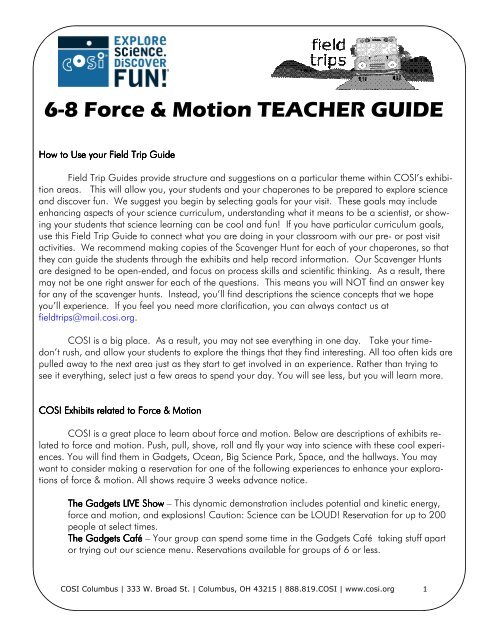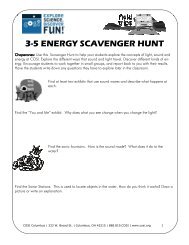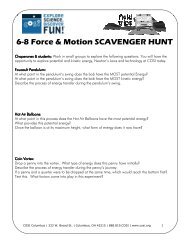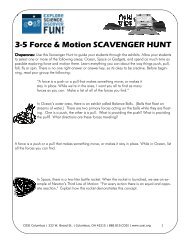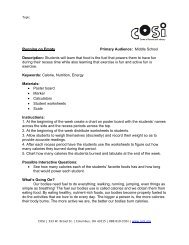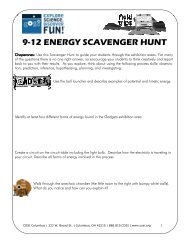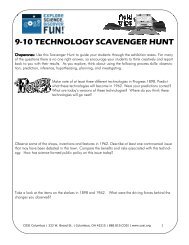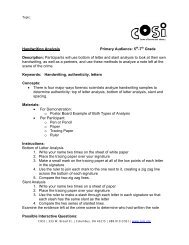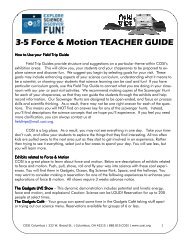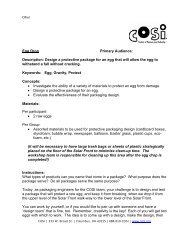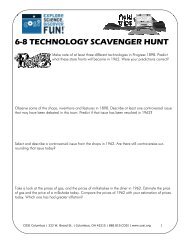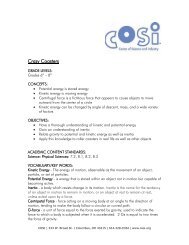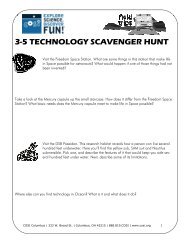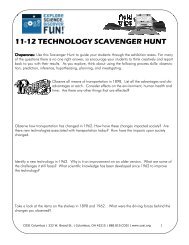6-8 Force & Motion TEACHER GUIDE - COSI
6-8 Force & Motion TEACHER GUIDE - COSI
6-8 Force & Motion TEACHER GUIDE - COSI
You also want an ePaper? Increase the reach of your titles
YUMPU automatically turns print PDFs into web optimized ePapers that Google loves.
6-8 <strong>Force</strong> & <strong>Motion</strong> <strong>TEACHER</strong> <strong>GUIDE</strong><br />
How to Use your Field Trip Guide<br />
Field Trip Guides provide structure and suggestions on a particular theme within <strong>COSI</strong>’s exhibition<br />
areas. This will allow you, your students and your chaperones to be prepared to explore science<br />
and discover fun. We suggest you begin by selecting goals for your visit. These goals may include<br />
enhancing aspects of your science curriculum, understanding what it means to be a scientist, or showing<br />
your students that science learning can be cool and fun! If you have particular curriculum goals,<br />
use this Field Trip Guide to connect what you are doing in your classroom with our pre- or post visit<br />
activities. We recommend making copies of the Scavenger Hunt for each of your chaperones, so that<br />
they can guide the students through the exhibits and help record information. Our Scavenger Hunts<br />
are designed to be open-ended, and focus on process skills and scientific thinking. As a result, there<br />
may not be one right answer for each of the questions. This means you will NOT find an answer key<br />
for any of the scavenger hunts. Instead, you’ll find descriptions the science concepts that we hope<br />
you’ll experience. If you feel you need more clarification, you can always contact us at<br />
fieldtrips@mail.cosi.org.<br />
<strong>COSI</strong> is a big place. As a result, you may not see everything in one day. Take your timedon’t<br />
rush, and allow your students to explore the things that they find interesting. All too often kids are<br />
pulled away to the next area just as they start to get involved in an experience. Rather than trying to<br />
see it everything, select just a few areas to spend your day. You will see less, but you will learn more.<br />
<strong>COSI</strong> Exhibits related to <strong>Force</strong> & <strong>Motion</strong><br />
<strong>COSI</strong> is a great place to learn about force and motion. Below are descriptions of exhibits related<br />
to force and motion. Push, pull, shove, roll and fly your way into science with these cool experiences.<br />
You will find them in Gadgets, Ocean, Big Science Park, Space, and the hallways. You may<br />
want to consider making a reservation for one of the following experiences to enhance your explorations<br />
of force & motion. All shows require 3 weeks advance notice.<br />
The Gadgets LIVE Show – This dynamic demonstration includes potential and kinetic energy,<br />
force and motion, and explosions! Caution: Science can be LOUD! Reservation for up to 200<br />
people at select times.<br />
The Gadgets Café – Your group can spend some time in the Gadgets Café taking stuff apart<br />
or trying out our science menu. Reservations available for groups of 6 or less.<br />
<strong>COSI</strong> Columbus | 333 W. Broad St. | Columbus, OH 43215 | 888.819.<strong>COSI</strong> | www.cosi.org 1
6-8 <strong>Force</strong> & <strong>Motion</strong> <strong>TEACHER</strong> <strong>GUIDE</strong><br />
BIG SCIENCE PARK<br />
Big Science Park is strictly Big Fun for your head and body as big experiments await your exploration.<br />
Big Science Park fosters the spirit of learning by putting you into the experiments, so you become a<br />
part of the science. As in all of the exhibition areas, there is no food, drink, or smoking in Big Science<br />
Park. Some great exhibits for your students to explore include:<br />
• The Centripetal Generotor will allow you and your students to feel inertia, friction, gravity, and<br />
centripetal force in action. As the ‘Rotor spins, your body is forced against the walls, so when<br />
the floor drops below you, your body remains suspended. Young children can focus on the<br />
idea of gravity, and a push or pull. This is experience is open weather permitting. Certain restrictions<br />
apply.<br />
• The Granite Sphere- Are you strong enough to move a 2,500-pound object? Give the granite<br />
sphere a push and see how reducing friction can make things easier to move. The inch of water<br />
under the sphere allows for the sphere to roll easily than it would if it were in contact with<br />
the ground.<br />
• The Giant Lever - Get a body-on understanding of simple machines as you lift a 2437-pound<br />
(1105.4 kg) 1961 Mercury Comet! This is a class-1 lever, with a fulcrum between the load and<br />
the effort. Try both ropes. Which one is easier? Which one takes longer?<br />
<strong>COSI</strong> Columbus | 333 W. Broad St. | Columbus, OH 43215 | 888.819.<strong>COSI</strong> | www.cosi.org 2
6-8 <strong>Force</strong> & <strong>Motion</strong> <strong>TEACHER</strong> <strong>GUIDE</strong><br />
OCEAN<br />
Poseidon's realm takes two forms in this unique learning environment. On one side of the exhibition,<br />
Poseidon reigns majestic over a mythical playground, symbolizing the ancient means for understanding<br />
the sea. Here, you can explore the physical nature of water through laminar streams, eroding<br />
sand, and other activities, and at the same time being totally immersed in a theatrical recreation of<br />
the ocean's power. On the other side of Ocean, Poseidon is the namesake of an undersea research<br />
habitat, revealing the modern means for understanding the sea. Based on real ocean exploration<br />
technology, the "D.S.B. Poseidon" uses submersibles sonar to explore the scientific side of Ocean.<br />
Caution: It is likely that your students will get wet. Encourage them to take care not to get others wet in<br />
the process. Exhibits include:<br />
The Cartesian Diver Divers will sink when their density is greater than the water surrounding them.<br />
This is accomplished with a buoyancy compensator (BC) that they wear. As the air is removed,<br />
the BC will deflate. This decreases the divers overall volume, making him/her more dense than<br />
the surrounding water. Can you get <strong>COSI</strong>’s diver to go up and down? How about remain neutrally<br />
buoyant (the middle)?<br />
Erosion Table As water is pulled by gravity to lower levels, it exerts a force of change upon the surface<br />
on which it travels. This force of change is called erosion. The erosion table demonstrates fluvial<br />
(water) erosion on landmass. Where does the sand go? Where is sand washed away<br />
faster? Slower? Why? Are there any areas that have no sand? Where? How would you explain<br />
this observation? What ideas do you have to stop the flow of water? What do you think<br />
will happen when the water is blocked? (Make and share predictions.) Have students construct<br />
a dam with the sand and compare their predictions with their observations about the dam.<br />
Ball Fountains You will notice that the ball is spinning. The moving water sticks to the bottom of the<br />
ball and then is thrown from the top of the ball. The thrown water moves in one direction,<br />
causing the ball to move in the other direction. This is an example of Newton’s Third Law of<br />
<strong>Motion</strong>: For every action, there is an equal and opposite reaction.<br />
Laminar Flow The water coming out of the water cannons is an example of laminar flow. Notice that<br />
this water is much less turbulent than the water in your kitchen sink. Does if feel or look different<br />
than other streams of water you have seen? How is it different?<br />
Water Jets Notice water popping up from the floor. Pumps push the water up and gravity pulls it<br />
back down. What else doe you notice? Does the water spray out or stick together? What<br />
makes it do that?<br />
<strong>COSI</strong> Columbus | 333 W. Broad St. | Columbus, OH 43215 | 888.819.<strong>COSI</strong> | www.cosi.org 3
6-8 <strong>Force</strong> & <strong>Motion</strong> <strong>TEACHER</strong> <strong>GUIDE</strong><br />
GADGETS<br />
Admired for their ability to change how we do things, gadgets are tangible proof of how creativity<br />
advances technology. The Gadgets exhibition area contains a variety of exhibits that allow guests<br />
to explore the building blocks of more complex gadgets: pulleys, gears, lasers, and electric circuits.<br />
Guests can examine the inner workings of everyday gadgets by taking them apart in the Gadgets<br />
Café. The café is an inventor's paradise that offers the tools necessary to investigate the gadgets we<br />
use daily. <strong>Force</strong> and motion exhibits include:<br />
• Pulley Chairs - An example of a simple machine that makes life easier. Each chair has a<br />
different number of pulleys, so you can try them all and feel the difference. If there are more<br />
pulleys, you expend less effort.<br />
• Air Cannon - Have some fun with the Air Cannon in the back of Gadgets. Toss a ball in<br />
and turn the handle to launch. Air from the compressor will push the ball. Try two or five or<br />
ten balls. What happens?<br />
• Flying Propellers -Control the speed of the flying propellers, causing them to rise, fall, or<br />
hover on a pole that reaches the ceiling. The faster the propeller spins, the more air it<br />
pushes down, causing lift.<br />
• Newton’s Nozzles - Balance a ball inside a path of airflow. Air is pushing up on a ball.<br />
Since the ball is curved, the air travels over top of the ball. This action holds the ball in<br />
place. This is an excellent demonstration of Newton’s third law: for every action there is an<br />
equal and opposite reaction.<br />
<strong>COSI</strong> Columbus | 333 W. Broad St. | Columbus, OH 43215 | 888.819.<strong>COSI</strong> | www.cosi.org 4
6-8 <strong>Force</strong> & <strong>Motion</strong> <strong>TEACHER</strong> <strong>GUIDE</strong><br />
SPACE<br />
How big is the universe? What drives humanity to the stars? These are questions that have<br />
piqued the curiosity of many, and whose answers change as we gain more information about the universe.<br />
Space offers opportunities to think about these questions while at the same time relive some of<br />
history's great space explorations. Enter the exhibit through the Black Hole, a cool spinning sensory<br />
experience, or sit in the Living Room and watch the history of space travel. Please ask students to use<br />
caution in the tunnel.<br />
Overhead Thrusters Listen for the hissing sound. This is the sound of air being pushed through the<br />
thruster’s nozzles, causing thrust. Thrust is the primary means of acceleration in space. In space, propellant<br />
is pushed through a nozzle instead of air. Thrust from the air being forced through the nozzles<br />
causes the thruster to move. The thruster has inertia. Inertia refers to an object’s tendency to keep<br />
moving or the resistance to changes in motion. Until an outside force (air resistance, friction, collision)<br />
acts upon the thruster, it will continue to move. These thrusters will eventually stop on their own due to<br />
drag. The primary forces are air resistance (drag) and friction. In space, however, there is little gas,<br />
which means, little drag. To stop a thruster here or in space, apply thrust in opposite direction. How<br />
do Newton’s laws of motion relate to this exhibit? Newton’s first law of motion (objects in motion tend<br />
to stay in motion) explains why the thruster continues to fly after the thrust is disengaged. The thruster<br />
will continue to fly until some force opposes that motion. Newton’s second law (force = mass * acceleration)<br />
dictates the rate at which the thruster will accelerate when a force is applied either from thrust<br />
or air friction. Newton’s third law (every action has an equal and opposite reaction) is demonstrated<br />
by the simultaneous push the thruster exerts on the fuel (air) and push the fuel exerts on the thruster.<br />
The Rocket Launch exhibit invites guests to "fuel up" a rocket by charging a projectile with compressed<br />
air. Guests then perform their own countdown and release the miniature rocket, watching it arc 25<br />
feet up to the ceiling. Rockets go because of Newton’s Third Law: For every action there is an equal<br />
and opposite reaction. Spent fuel escapes the rocket through a hole called the nozzle. This is the action.<br />
The rocket moves away from the spent fuel, in effect pushing against it. This is the reaction. The<br />
more spent fuel the rocket leaves behind, and the faster the spent fuel moves, the faster the rocket will<br />
fly. Notice that the rocket does not push against the launch pad, the air, or anything else except its<br />
own fuel. This is the reason rockets can work in outer space.<br />
<strong>COSI</strong> Columbus | 333 W. Broad St. | Columbus, OH 43215 | 888.819.<strong>COSI</strong> | www.cosi.org 5
6-8 <strong>Force</strong> & <strong>Motion</strong> <strong>TEACHER</strong> <strong>GUIDE</strong><br />
Vocabulary Words<br />
These are some <strong>Force</strong> & <strong>Motion</strong> terms that you should be familiar with as you explore <strong>COSI</strong> with your<br />
students:<br />
<strong>Force</strong>: A push or pull on an object. You can observe a force when something flies, falls, spins,<br />
drops, rolls or stops.<br />
Gravity: The earth’s pull on things.<br />
Mass: A measure of quantity of matter in an object.<br />
Newton’s First Law of <strong>Motion</strong>- An object in motion will stay in motion unless acted upon by an<br />
outside force, or things will keep on doing what they are doing until something stops them.<br />
This is also known as inertia.<br />
Newton’s Second Law of <strong>Motion</strong>: <strong>Force</strong> =Mass x acceleration, which translates to this: the<br />
more mass an object has, the more you have to push it. The harder you push an object, the<br />
farther it will go. Newton’s Third Law of <strong>Motion</strong>: When you push on an object, it pushes<br />
back, and is often referred to as action and reaction. This is not the same as cause & effect.<br />
Speed: how far something goes in a certain amount of time.<br />
Velocity: How fast and in what direction something is going.<br />
Weight: The amount of gravitational pull on an object.<br />
Process Skills are the actions that it takes to “do science.” These are some of the scientific process<br />
skills that your students will be using as they explore the exhibits at <strong>COSI</strong>.<br />
Observe - Use your senses to gather information.<br />
Measure- Use tools and numbers to quantify objects or phenomena.<br />
Categorize - Place objects into groups based on similarities or differences.<br />
Communicate - Use words, pictures, graphs and diagrams to share your ideas.<br />
Investigate - Follow a scientific method to formulate questions, conduct an experiment.<br />
Apply - Put the information you’ve gathered to use.<br />
Infer – Make an assumption based on your observations.<br />
Question – Wonder and ask about things and find ways to discover answers.<br />
Predict - Decide what will happen in the future based on your observations.<br />
<strong>COSI</strong> Columbus | 333 W. Broad St. | Columbus, OH 43215 | 888.819.<strong>COSI</strong> | www.cosi.org 6
6-8 <strong>Force</strong> & <strong>Motion</strong> <strong>TEACHER</strong> <strong>GUIDE</strong><br />
Standards<br />
Grade 7 Physical Science<br />
2. Describe how an object can have potential energy due to its position or chemical composition<br />
and have kinetic energy due to its motion.<br />
Grade 7 Scientific Inquiry<br />
2. Identify simple dependent and independent variables.<br />
3. Formulate and identify questions to guide scientific investigations that connect science concepts<br />
and can be answered through scientific investigation.<br />
Grade 8 Physical Science<br />
1. Describe how the change in position ( motion) of an object is always judged and described<br />
in comparison to a reference point.<br />
2. Explain that motion describes the change in the position of an object (characterized by<br />
speed and direction) as time changes.<br />
3. Explain that an unbalanced force acting on an object changes that object’s speed and/or<br />
direction.<br />
Resources<br />
http://www.kidsolr.com/science/index.html<br />
Lots of excellent science links for kids.<br />
www.howstuffworks.com - Just about everything you’ve ever wanted to know is described at this informative<br />
and understandable website.<br />
www.physics4kids.com This website, although void of activities, has clear and accessible definitions of<br />
a variety of physics terminology such as energy, forces, and friction.<br />
http://www.exploratorium.edu/snacks/iconmagnetism.html Some cool activities from the Exploratorium<br />
related to magnetism.<br />
http://www.sciencenetlinks.com/lessons.cfm?BenchmarkID=4&DocID=405<br />
A lesson on gravity and other forces related to the launch of an object.<br />
http://www.mos.org/sln/Leonardo/InventorsToolbox.html<br />
Description of simple machines<br />
<strong>COSI</strong> Columbus | 333 W. Broad St. | Columbus, OH 43215 | 888.819.<strong>COSI</strong> | www.cosi.org 7
6-8 <strong>Force</strong> & <strong>Motion</strong> <strong>TEACHER</strong> <strong>GUIDE</strong><br />
Classroom Connections<br />
Your visit to <strong>COSI</strong> should not a one day event, soon to be forgotten. Help your students make<br />
connections between the classroom lessons and your field trip by doing activities related to your visit.<br />
Before your visit, review the vocabulary words that the students will encounter, and brainstorm things<br />
they already know about technology or <strong>COSI</strong> in general. Give them descriptions of each of the areas<br />
and some of your expectations. If possible, review with the chaperones, so they know what to expect.<br />
After your visit, have your students draw pictures or write letters of stories about their experience, and<br />
list questions they still have that you could explore together.<br />
Below are some lessons that you can use as pre-visit or post-visit activities to help connect your<br />
field trip to your classroom experiences and extend your students’ learning. Consider doing one activity<br />
every day for a week before your visit.<br />
Exploring Pendulums<br />
http://www.sciencenetlinks.com/lessons.cfm?Grade=6-8&BenchmarkID=4<br />
Exploring Magnetic Fields<br />
http://www.sciencenetlinks.com/lessons.cfm?Grade=6-8&BenchmarkID=4&DocID=266<br />
Fast Cars/ Slow Riders<br />
http://www.pbs.org/wgbh/nova/teachers/activities/2208_fastcars.html<br />
Wright Brothers Flying Machines<br />
http://www.pbs.org/wgbh/nova/teachers/activities/3015_wright.html<br />
Top Gun Over Moscow<br />
http://www.pbs.org/wgbh/nova/teachers/activities/2315_topgun.html<br />
<strong>Force</strong>s & <strong>Motion</strong><br />
http://school.discovery.com/lessonplans/programs/forcesandmotion/<br />
<strong>Force</strong>s, <strong>Motion</strong>, Energy & Electricity<br />
http://school.discovery.com/lessonplans/programs/motionforces/<br />
<strong>COSI</strong> Columbus | 333 W. Broad St. | Columbus, OH 43215 | 888.819.<strong>COSI</strong> | www.cosi.org 8
6-8 <strong>Force</strong> & <strong>Motion</strong> <strong>TEACHER</strong> <strong>GUIDE</strong><br />
After Your Visit/ Assessment<br />
Use the following activities to assess the impact of the visit to <strong>COSI</strong> on your students’ knowledge, attitudes,<br />
and perceptions. Use a standard project rubric to assess the product of each of these projects.<br />
If you would like, send stories, pictures, or descriptions of your project to <strong>COSI</strong> c/o Field Trips, 333<br />
W. Broad St., Columbus, OH 43215.<br />
Make a Great Gravity Gizmo!<br />
Objective: Use all of your understanding of force and motion to build a device that will cause an object<br />
to move all around your room (think of the game “Mousetrap,” or a roller coaster).<br />
Materials: Random objects brought in from home or around the classroom.<br />
Procedure:<br />
1. Work together to build the biggest, longest, craziest path you can. Some components you<br />
may want to include:<br />
A ramp made from cardboard tubes or pipe insulation<br />
A boat that sails across a sink full of water<br />
A catapult that launches the ball<br />
A rocket balloon that crosses a string<br />
A pulley that lifts a basket<br />
2. Label components and forces along the way.<br />
3. Test and revise your design as needed.<br />
4. What forces did you notice? How many devices did you use? How many different ways did<br />
you make your marble move?<br />
Objective: Assess perceptions of science<br />
Materials: pencil & paper<br />
Procedure:<br />
What is science?<br />
1. Ask students to write an essay or draw picture answering the question “What is science?”<br />
2. Discuss some of the following: What is science? What are some of the benefits? The challenges?<br />
What are the best parts of science? The worst parts? What does a scientist look<br />
like? Are you a scientist?<br />
<strong>COSI</strong> Columbus | 333 W. Broad St. | Columbus, OH 43215 | 888.819.<strong>COSI</strong> | www.cosi.org 9


